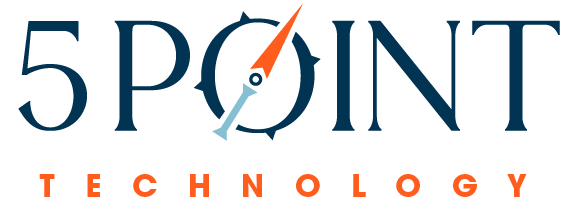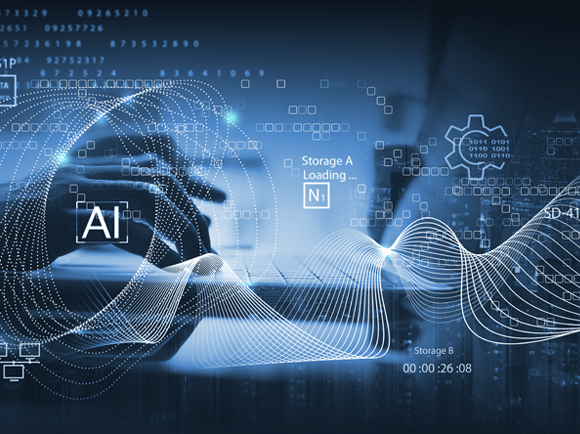AI and cloud technology are driving modern operations. They help businesses scale faster, process more data, and make better real-time decisions. Whether automating tasks or powering more intelligent analytics, this combination has changed what’s possible.
However, new risks emerge as companies move more sensitive workloads to the cloud and embed AI into daily operations. Cyber threats are more sophisticated. Compliance requirements are tighter. And without a proper security foundation, the same tools that deliver a competitive edge could expose your organization to threats.
How AI & Cloud Technology Are Driving Digital Transformation
AI and cloud platforms now work in tandem to allow organizations to scale services on demand, test new ideas faster, and uncover efficiencies that weren’t possible before. Cloud infrastructure removes the barrier of costly on-site hardware by making it easier to deploy compute-heavy AI models. At the same time, AI extracts deeper insights from the cloud-based data and tools companies already rely on.
This momentum is backed by significant investment. In 2025, spending on AI embedded in cloud platforms reached $59 billion, and 71% of Fortune 500 companies now maintain dedicated AI budgets, up from 58% the year prior.1
These numbers highlight how quickly enterprises move from experimentation to fully operational AI strategies in the cloud.
Benefits for Enterprise IT
For IT leaders, cloud technology and AI synergy deliver tangible benefits. Teams can spin up environments in minutes instead of weeks, automate processes, reduce downtime, and manage resources effectively. With AI for enterprise use cases like fraud detection, demand forecasting, or customer segmentation, IT shifts from a support role to a growth driver.
Keeping AI for IT Secure
The problem is that greater integration creates more potential entry points for attackers. Each new AI model or API adds complexity and expands the threat surface. IT leaders must develop AI cloud security strategies beyond basic controls to stay ahead. This includes identity governance, threat monitoring, and clear boundaries between AI workloads and other systems.
Security Challenges Unique to AI in the Cloud
The vast amounts of training data, evolving models, and dynamic APIs that AI workloads rely on make securing them more complex and urgent. And while AI in the cloud provides robust capabilities, it introduces new vulnerabilities, too. Here are a few of the weaknesses that AI brings to the cloud.
AI Model & Data Threats
AI systems are only as trustworthy as the data and models supporting them. If attackers manipulate training data (model poisoning) or inject malicious prompts (prompt injection), the outcomes can be disastrous. Even without direct access, unauthorized inference attacks can expose sensitive data or reveal internal logic, putting the business at risk.
Cloud Infrastructure Weak Points
Cloud infrastructure remains a common target. Misconfigured access controls, open APIs, and shared environments leave room for errors that bad actors can exploit. To close these gaps, a secure cloud infrastructure must include least-privilege access, encrypted communication, and continuous configuration validation.
Compliance in AI-Driven Environments
AI adds layers of complexity to existing compliance frameworks. Regulations like HIPAA, GDPR, and CCPA require clarity on data lineage, processing logic, and access controls, areas where many AI systems fall short. Meeting these standards demands tools and processes built for transparency, documentation, and audit-readiness.
Building a Secure AI & Cloud Technology Foundation
Securing AI workloads in the cloud begins with planning. You must design every layer—from network to data pipelines—with security, performance, and resilience in mind. Let’s look at how you can do this.
Zero Trust for AI Workloads
AI workloads often involve sensitive data and high-value models. A Zero Trust approach limits exposure and keeps critical systems isolated.
- Apply strict identity and access management (IAM)
- Segment networks to isolate AI systems from general infrastructure
- Use encryption and monitoring across all endpoints
These controls reinforce AI cloud security and help reduce lateral movement in case of a breach.
Cloud Migration Consulting for AI Readiness
Migrating AI workloads requires a careful strategy. A misstep can lead to downtime, data loss, or misalignment with compliance.
- Start with a comprehensive risk assessment
- Plan infrastructure around AI-specific needs like compute and storage
- Test workloads in controlled environments before going live
Cloud migration consulting helps align technical decisions with long-term business goals.
Cloud Infrastructure Optimization for AI Performance
AI workloads are resource-intensive. Cloud infrastructure optimization helps avoid overprovisioning while ensuring performance.
- Right-size compute and memory for each workload
- Use autoscaling and load balancing to manage demand
- Optimize storage for throughput and latency
This keeps systems responsive and cost-efficient.
Resiliency Planning
AI systems require high availability to deliver consistent business value. A solid resiliency strategy ensures continuity even when something breaks.
- Implement backup policies tailored to AI datasets
- Design for failover and redundancy across regions
- Build disaster recovery workflows into AI pipelines
These practices reduce downtime and preserve model integrity.
AI Data Management & Governance in the Cloud
Strong data governance is essential for AI to deliver value without compromising security or compliance. In the cloud, that means managing every phase of the data lifecycle with precision.
Securing AI Data Pipelines
AI data moves through multiple stages, each with potential exposure points. To keep it protected:
- Encrypt data at rest and in transit using industry-standard protocols
- Enforce multi-factor authentication for access to critical systems
- Route all data access through secure API gateways
This protects both structured and unstructured data across environments.
AI Data Management Best Practices
Good governance isn’t just about security but accountability and fairness.
- Track data lineage to verify where data originated and how it changed
- Maintain detailed audit logs to support regulatory compliance
- Apply bias detection and mitigation tools during training to improve fairness and transparency
These practices support ethical AI development and prevent future liabilities.
Protecting High-Value Training Data
Training data is often proprietary or sensitive. A breach could expose intellectual property or confidential records.
- Restrict access based on job role and need-to-know
- Validate and sanitize input data to block manipulation attempts
- Use tamper-proof logs to track who accessed what, when, and why
When training data is secured, AI models are more reliable and defensible.
Compliance, Risk & Trust in AI & Cloud Technology
Compliance is a strategic risk management priority as AI and cloud technology become central to enterprise operations. The challenge is that many regulations weren’t designed with AI in mind, putting added pressure on IT and compliance teams to adapt quickly.
Regulatory Challenges
HIPAA, GDPR, and CCPA have strict data collection, storage, and sharing rules. When AI enters the picture, those rules get more complicated. Models may use sensitive health or consumer data to predict or automate decisions. That raises questions about consent, explainability, and access rights. Organizations risk noncompliance without clear documentation and audit trails, even if their intentions are sound.
Continuous Compliance Monitoring
Compliance monitoring must happen in real time, not after the fact, to stay ahead. Automated tools can scan configurations, flag policy violations, and send alerts when systems drift out of alignment. This approach transforms compliance from a periodic scramble into a continuous, built-in safeguard. It also reduces the risk of surprise audits or fines.
AI for IT Governance
AI itself can help manage governance more effectively. AI tools can help security and compliance teams spot gaps and tighten controls by analyzing system logs, usage patterns, and access histories. Organizations can build a more resilient and transparent approach to data and AI oversight with a unified strategy that connects IT, legal, and risk stakeholders.
How 5 Point Technology Secures AI & Cloud Technology Environments
AI and cloud systems demand a partner who understands the risks and how to manage them. At 5 Point Technology, we integrate security into every service we offer. From migration to optimization, we help partners build resilient environments that support growth without compromising compliance or data integrity.
Cloud Migration Consulting with Security at the Core
Successful AI adoption starts with a secure, well-planned migration. Our cloud migration consulting services minimize disruption while safeguarding sensitive workloads. We assess risks upfront, create tailored migration roadmaps, and test every stage to ensure AI applications run securely and efficiently in the cloud.
Managed AI Cloud Security Services
Security threats don’t keep business hours, neither do we. With 24/7 monitoring and SOC-as-a-Service, our managed security services give partners around-the-clock protection. We combine automated threat detection with expert-led response protocols to contain incidents fast and reduce risk across AI-powered environments.
Optimization for AI-Driven Workloads
AI systems place high demands on compute, memory, and storage. Our optimization services help partners fine-tune their cloud infrastructure to deliver top performance while staying within budget. We identify inefficiencies, recommend right-sized solutions, and apply strategies to optimize cloud infrastructure for real-time AI workloads.
Is Your AI & Cloud Technology Infrastructure Secure?
As AI adoption grows, so does the need for a secure, well-governed cloud environment. These guiding questions can help you evaluate whether your setup supports innovation and protection.
Quick Self-Assessment Guide
- Have you isolated AI workloads from broader IT systems to reduce exposure?
- Are all sensitive datasets encrypted during storage and transit?
- Is access to training data limited to specific roles with explicit permissions?
- Do you have documented policies for training, validating, and updating AI models?
- Is your cloud infrastructure routinely tested for vulnerabilities and compliance gaps?
- Are real-time monitoring tools in place to detect threats or unusual behavior?
- Can your organization demonstrate regulatory readiness under HIPAA, GDPR, or CCPA?
If these questions raise concerns or you’re unsure how to answer, your AI strategy may need a second look.
The Case for Expert Support
AI and cloud technology should move your business forward, but without the right security, they can expose your organization to costly risks. The financial stakes are clear: the 2025 IBM Cost of a Data Breach Report found that the average breach costs $4.4 million. Nearly 97% of companies that experienced AI-related incidents lacked proper access controls, and 63% had no AI governance policies in place.2
The takeaway: investing in prevention and expert guidance delivers far greater returns than reacting after a breach. At 5 Point, we bring clarity, structure, and confidence to every stage of the journey. Whether you’re preparing for your first AI deployment or scaling an existing environment, we help you secure what matters most.
Request an AI and Cloud Technology readiness and security assessment today.
References



